
NCAR Graphics: An integrated solution




With the release of Version 4, NCAR Graphics continues its evolution
into an integrated environment for data processing and scientific
visualization. The package contains multiple interfaces to accommodate
diverse user skill levels and application needs. Many tools come
bundled with the distribution to perform such functions as viewing and
editing metafiles, creating animations, converting between raster
formats, resizing and compressing raster images, and zooming on
images.
NCAR Graphics produces output files based on popular industry
standards, such as PostScript and Computer Graphics Metafile
(CGM). This allows you to import NCAR Graphics plots into non-NCAR
visualization tools that run on Macintoshes, Personal Computers (PCs),
and UNIX systems.
Enhanced features, wider accessibility
Version 4 adds capabilities that make it easier than ever to create
exceptional scientific graphics:
- NCAR Command Language
- New to Version 4 is a powerful data processing language called
the NCAR Command Language. The language provides strong data handling
and data manipulation facilities and supports a variety of data
formats, including Network Common Data Form (netCDF), Hierarchical
Data Format (HDF), binary, and ASCII.
- High-Level Utilities
- The High-Level Utilities library provides a collection of graphical
objects with which you can easily generate custom visualizations.
- Hypertext documentation system
- New documentation provides hypertext capabilities for interactive
access to reference material, user information, code examples, and
online animations. You can use online documentation maps and other
navigational aids to locate specific information.
- Site licenses
- With the new NCAR Graphics site license, you can install NCAR Graphics
on all UNIX systems at your site for use by an unlimited number of
staff.
A tradition of excellence
NCAR Graphics has been at the forefront of scientific visualization
for 20 years. The popularity of the package is due to the care
developers have taken to ensure:
- Real-world data compatibility
- NCAR Graphics allows you to handle real-world data. For instance, NCAR
Graphics plotting routines accept and display datasets that have
missing values, and contouring and curve plotting objects can display
data that have nonlinear coordinate spacing in either or both
dimensions.
- Upward compatibility
- As NCAR Graphics moves forward with new capabilities and
features, it maintains upward compatibility for your entry routines.
- UNIX portability
- You can use NCAR Graphics on most major UNIX systems. A list of
currently supported systems is available on the Internet's World Wide
Web at the following URL: http://ngwww.ucar.edu/
- Source code availability
- The NCAR Graphics package includes Fortran and C source code for
low-level graphics libraries. This allows you to adapt and port your
codes to non-UNIX systems if necessary.
- Adherence to standards
- NCAR Graphics utilizes most major standards—for example, Fortran 77,
American National Standards Institute (ANSI) C, X Window System,
Motif, Graphical Kernel Standard (GKS), CGM, PostScript, netCDF, and
HDF.
Multiple interfaces for different needs
Version 4 offers three interfaces . . . choose the one that meets your
exact needs.
Interactive programming power:
NCAR Command Language Interface
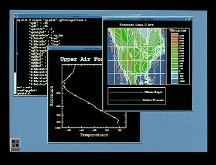
The NCAR Command Language is a powerful interpreted language for
reading, writing, and manipulating scientific data. It uses an
internal netCDF data model, but handles input data in a variety of
formats. The command language provides many functions for manipulating
data (including sorting) as well as arithmetic and trigonometric
functions. As part of an integrated package, the NCAR Command Language
can create any visualization supported by the High-Level Utility
interface, including XY plots and contour plots with maps, legends,
labelbars, and other annotations.
You can use the command language's looping constructs to create
animations; you can also subscript arrays directly with latitude and
longitude values. You can execute the NCAR Command Language
interactively from the command line or as a batch script.
Toolkit convenience:
High-Level Utility Interface
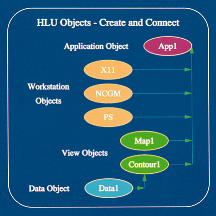
Version 4 includes the new High-Level Utility library, which provides
routines to create and manipulate graphical objects. This interface
makes it easier to produce complex visualizations. The interface
includes both Fortran and C bindings.
Legacy code compatibility:
Low-Level Utilities Interface
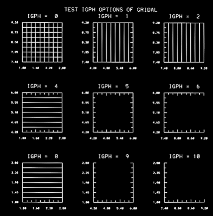
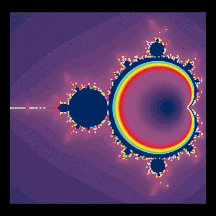
NCAR Graphics continues to provide about 500 low-level plotting
routines. Both Fortran and C bindings will continue to support your
NCAR Graphics code in an upwardly compatible manner.
Diverse functionality for superior visualizations
NCAR Graphics is a leader in the market of scientific
functionality. Robust utilities let you create precise, sophisticated
visualizations of your data. Multiple graphical output formats include
CGM, NCAR encoded CGM (NCGM), PostScript (PS, EPS, EPSI), and X11
direct. With NCAR Graphics, you can create numerous types of plots,
including:
Contour plots

- Vector and map overlays
- Raster contours
- Lines or filled contour levels
- Labelbars
- Legends
- General annotations
- Colors or grayscale
- Numerous projection types
Map plots

- Multiple projections
- Continental, political, and state boundaries
- Color or grayscale fill capability
- Regional masking capability
- Text and general annotations
- Inverse transformations
Weather maps
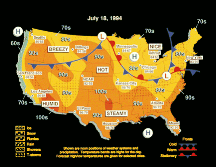
- Warm and cold fronts
- Filled contours and maps
- Weather condition symbols (snow, ice, fog, etc.)
- Complex annotations
- Legends
- Labelbars
- Wind barbs
XY plots
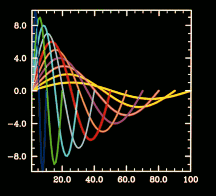
- Map overlays
- Multiple curves
- Legends
- Labels
- Linear, logarithmic, and irregular monotonic axes
- General annotations
Field flows

- Vectors
- Streamlines
- Numerous projection types
Histograms
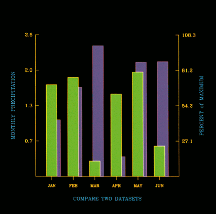
- Binned samples
- Raw samples
3-D wireframe surfaces

Text and annotations

- Extreme flexibility
- High-quality fonts
Overlays
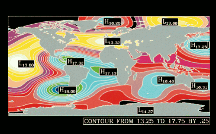
- XY tracks
- Contours
- Maps
- Annotations
Powerful tools for `post production'
A full array of translators, filters, conversion utilities, and
editors let you manipulate your data for publication-quality
visualizations.

Raster utilities
- Raster image viewing
- Image resizing
- Raster format conversion
- Image splitting and concatenation
- Listing of image-file contents
- Raster color palette replacement
Translators and filters
- NCGM readers/viewers
- Frame-level editing
- NCGM workstation animation
- Still frame and animation area zooming
- Format conversions
Additional commands
- NCAR Graphics Version 4 includes many example programs for creating
supported graphical objects. You can select a specific example and
copy it into your local working directory, where you can view it with
an editor. You can also execute an example program to produce a
graphic that you can view on your workstation/graphics terminal or
output to a graphics printer/plotter.
- Version 4 also contains commands that let you link your own Fortran or
C codes with the NCAR Graphics libraries.
A full range of support services

NCAR Graphics comes fully supported. You can depend on the following
services:
Consulting
- Installation consulting for designated system installers
- Usage consulting for designated site representatives
- Peer support e-mail newsgroup
Software maintenance
- Internet updates of bug fixes and minor upgrades
- Online comment and trouble report forms
Online information
- You can obtain up-to-date information---including bug reports,
Frequently Asked Questions (FAQ), and future plans---on the Internet's
World Wide Web at the following URL:
http://ngwww.ucar.edu/
For more information . . .
NCAR Graphics Information staff are happy to answer your questions
about the capabilities and availability of NCAR Graphics,
documentation, training and contract services, and provide you with
ordering details. For more information, send e-mail to the Internet
address ncarginf@ucar.edu or
call (303) 497-1201.

















